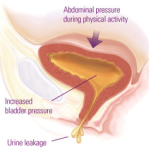What is Urinary Incontinence?
Loss of urine control or urinary incontinence occurs in people of all ages, but it is common in older people. At least 1 in 10 persons aged 65 years or older suffer from incontinence. This condition can range from the discomfort of slight losses of urine to the disability and shame of severe, frequent wetting.
Many people with incontinence withdraw from social life and try to hide the problem from their families, friends, and even their doctor.
These reactions are unfortunate because in most cases incontinence can be treated and controlled, if not cured.
Persons who have problems controlling urination should see their doctor. Even when incontinence cannot be completely cured, modern products and ways of managing the condition can ease the discomfort and inconvenience it causes.
Incontinence may be brought on by an illness accompanied by fatigue, confusion, or hospital admission. Incontinence is sometimes the first and only symptom of a urinary tract infection. Curing the illness usually will relieve or clear up the incontinence.
What are the types of incontinence?
The most common forms of urinary incontinence are listed below:
Stress incontinence is the leakage of urine during coughing, sneezing, or exertion that increases the abdominal
- pressure and thereby put pressure on the bladder. It is the most common type of incontinence and can almost always be cured.
- Urge Incontinence is the inability to hold urine long enough to reach a toilet. It is often found in people who have conditions such as diabetes, stroke, dementia, Parkinson’s disease, and multiple sclerosis. It can also be a warning sign of early bladder cancer. In men, it is often a sign of an enlarged prostate. It can, however, occur in otherwise healthy elderly persons.
- Mixed urinary incontinence is a combination of urge and stress incontinence.
- Overflow Incontinence is the leakage of small amounts of urine from a bladder that is always full. This may occur when the flow of urine from the bladder is blocked or loss of normal bladder sensations in some people with diabetes.
- Continuous urinary incontinence is the complaint of a continuous leakage of urine.
- Postmicturition dribble is the complaint of an involuntary loss of urine immediately after passing urine.
- Nocturnal enuresis is the complaint of loss of urine occurring during sleep.
- Extraurethral incontinence is the observation of urine leakage through channels other than the urethra (e.g., fistula or ectopic ureter).
What tests are to be done?
In addition to routine blood and urine tests, doctor may ask for Ultrasound abdomen, bladder diary and urodynamics depending on the history and examination.
Treatment of Urinary incontinence
Treatment of urinary incontinence should be tailored to each patient’s needs and accurate diagnosis. The many options include:
- Certain behavioral techniques-including pelvic muscle exercises, biofeedback, and bladder training are helpful in controlling urination. These help a person to sense bladder filling and delay voiding until he or she can reach a toilet.
- Certain vaginal support devices called pessary can be used in women who have prolapse and this would improve continence.
- A number of medications can be used based on type of incontinence. However, they must be used carefully under a doctor’s supervision.
- Sling operation for stress incontinence in women is common surgical procedure. Artificial sphincter devices that replace or aid the muscles controlling urine flow have been tried in persons with continuous incontinence. These devices require surgical implantation.
Are there other treatment options?
Sometimes when incontinence cannot be cured, or when patient is unfit for major surgical procedure, or if patient refuses surgery then it can be managed by other treatment strategies.
- Specially designed absorbent underclothing is available. Many of these garments are no more bulky than normal underwear and can be worn easily under everyday clothing.
- Incontinence may be managed by inserting a flexible tube known as a catheter into the urethra. This can be done intermittently every 4-6 hours to empty the bladder or by means of indwelling catheterization, the latter may be suprapubic or transurethral, and collecting the urine into a container. Indwelling catheterization sometimes creates problems, including urinary infections or stone formation. In men, an alternative to the indwelling catheter is an external collecting condom device. This is fitted over the penis and connected to a drainage bag. Other alternative in men is the external application of a special clamp which is applied over the penis and this can be released intermittently to empty the bladder.
- It is important to remember that under a doctor’s care, incontinence can be treated and often cured. Even incurable problems can be managed to reduce complications, anxiety, and stress.

